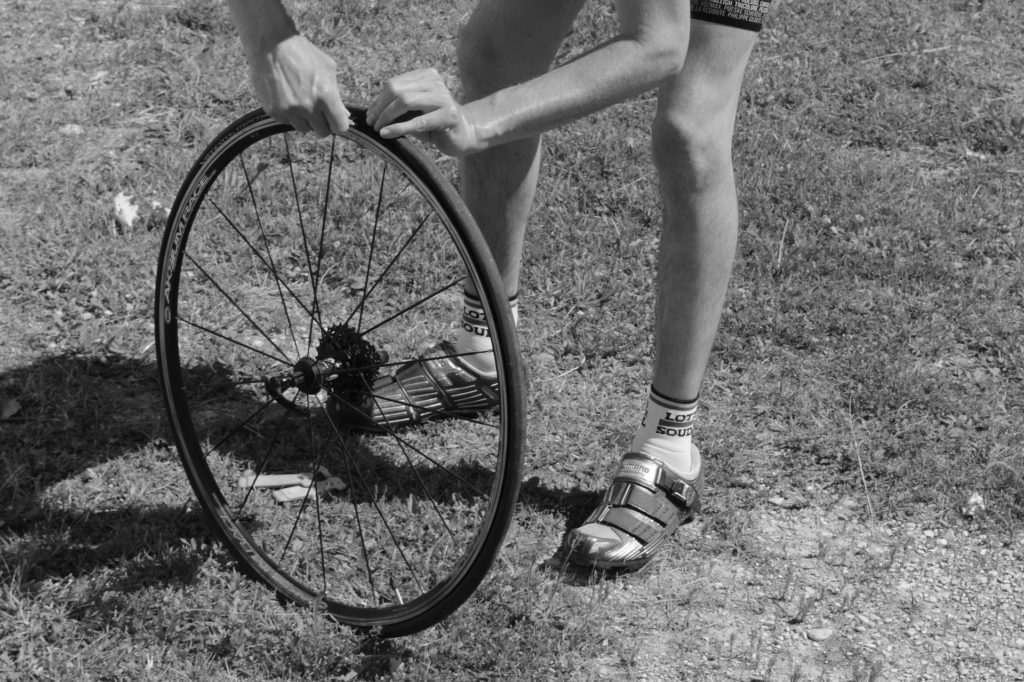If you’re a beginning cyclist, you’ll soon discover that knowing how to change a flat is an essential skill to master. It’s a well known fact that flat tires occur at the most inopportune moments. Therefore, understanding how to fix a bicycle flat quickly will ultimately save you a great deal of time and stress. Read the steps below to see how you can efficiently change your tires in order to minimize wasted time on the side of the road.
1. Take your tire off
First, remove the rest of the air in the flat tire. You can do this by indenting the plunger in the center of the tire valve. Then, unseat your tire bead by pushing one bead toward the rim’s center. Once a section of the tire bead is free, take off the rest of the tire with your fingers.
Note: If the bead is loose, taking the tire off by hand should be no problem. If not, you’ll have to slip a tire lever under the bead and slide it between tire and rim until one side is off. At this point, you’ll be able to pull off the damaged tire tube.
2. Check your tire for damage
As you take off the bicycle tube, be on the lookout for damage. Even small items like a nail or a tiny piece of glass could be the cause of your flat. It’s best and most efficient to begin looking on the outside and then working your way in. Check in between the treads and on the sidewalls of the tire. If you don’t see an object that caused the damage and instead notice two small holes next to each other, your tire could have a pinch flat caused by under inflation. Furthermore, the flat could be caused by a broken valve which would appear cracked or worn (in this case, the entire tube needs replacing). If you’ve checked all of these and still can’t figure out the cause of your flat, inflate your tube and check for escaping air. To make this easier, put the tube in water and watch for escaping bubbles that indicate a hole.
3. Fix/Replace the tube
Repairs are fairly simple and can be accomplished with a patching kit. You can find this at your local cycling store or at most superstores. The kit will include step-by-step instructions guiding you with clear directions. Typically, patches are accomplished by locating the area of damage, cleaning it, roughing the surface with sandpaper, applying glue, and then attaching a tire patch.
If you need to replace the entire tube, you’ll first check to see that the rim strip is seated properly. Then, inflate your new tube just a bit to give it a round shape. At the valve stem, lower the tube onto the wheel and put the valve into the rim valve hole. After that, put the rest of the tube inside of the tire. At this point, put the tire bead inside of the rim. Makes sure this is accomplished evenly and isn’t sticking out at any angles. Keep going around the wheel pushing both sides in towards the rim’s center. You could carefully use a tire lever if the job becomes difficult. Once the tire and valve are set, check the edges to make sure that the tube isn’t caught as this could cause another flat.
4. Slowly inflate your tire
As you do this, check to see that both sides of the rim are staying put. To make sure everything’s in place, go around the tire once more with your fingers and pinch the tire inwards. If your fingers press into the tire easily, keep inflating your tire until you reach the desired resistance.
Tips
- Ask a seasoned cyclist to show you in person how to change a tire. If you don’t know any cyclists, head out to your local cycling store and arrange an appointment where an expert can show you. There’s no substitute for a hands-on example to make sure you know how to change a bicycle flat properly.
- Practice changing your tire at home. Master this skill in the safety of your garage before finding yourself in the middle of nowhere without tire changing abilities!
- Make sure that you have all of the proper equipment on hand before you go on a ride. Acquiring the skill of changing a flat won’t matter if you don’t have what you need!
Best of luck on the road!
For more tips and tricks, check out these resources:

